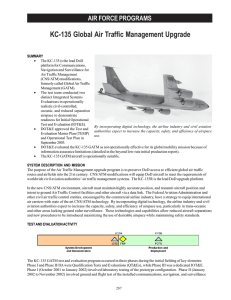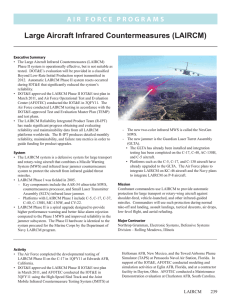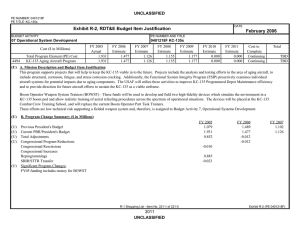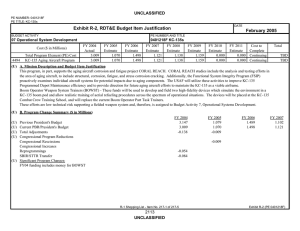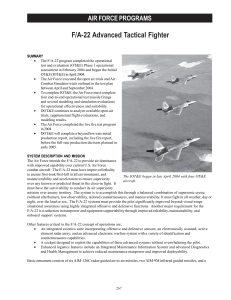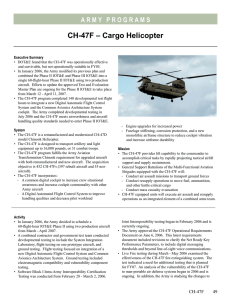T KC-135 Global Air Traffic Management (GATM) Upgrade AIR FORCE PROGRAMS
advertisement
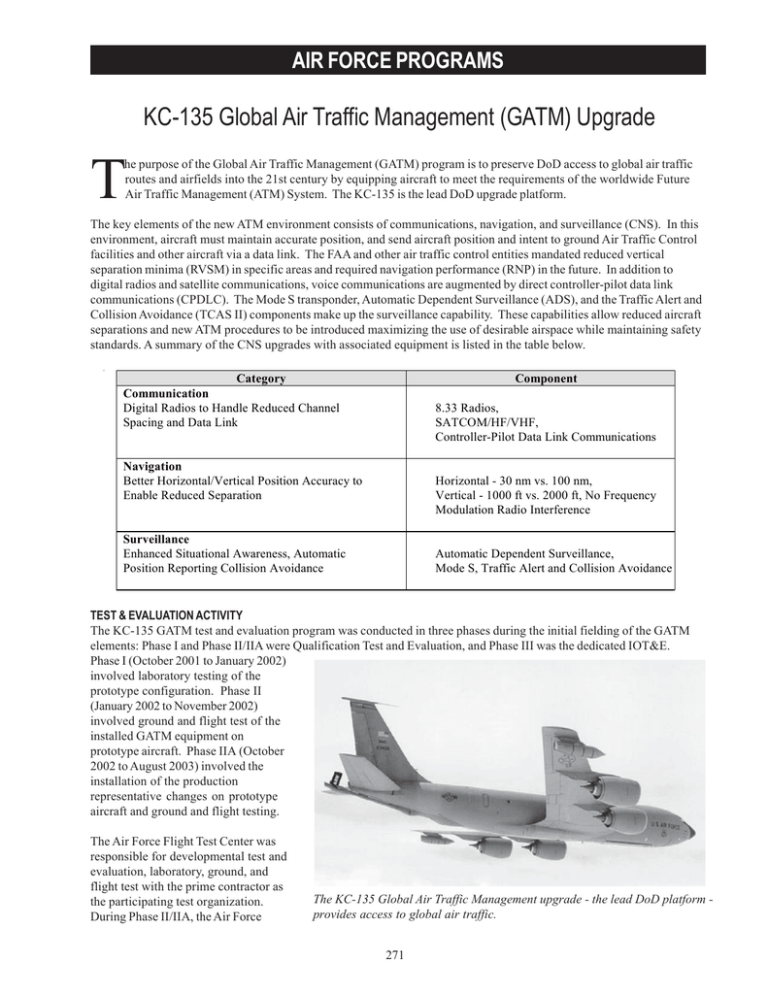
AIR FORCE PROGRAMS KC-135 Global Air Traffic Management (GATM) Upgrade T he purpose of the Global Air Traffic Management (GATM) program is to preserve DoD access to global air traffic routes and airfields into the 21st century by equipping aircraft to meet the requirements of the worldwide Future Air Traffic Management (ATM) System. The KC-135 is the lead DoD upgrade platform. The key elements of the new ATM environment consists of communications, navigation, and surveillance (CNS). In this environment, aircraft must maintain accurate position, and send aircraft position and intent to ground Air Traffic Control facilities and other aircraft via a data link. The FAA and other air traffic control entities mandated reduced vertical separation minima (RVSM) in specific areas and required navigation performance (RNP) in the future. In addition to digital radios and satellite communications, voice communications are augmented by direct controller-pilot data link communications (CPDLC). The Mode S transponder, Automatic Dependent Surveillance (ADS), and the Traffic Alert and Collision Avoidance (TCAS II) components make up the surveillance capability. These capabilities allow reduced aircraft separations and new ATM procedures to be introduced maximizing the use of desirable airspace while maintaining safety standards. A summary of the CNS upgrades with associated equipment is listed in the table below. Category Communication Digital Radios to Handle Reduced Channel Spacing and Data Link Component 8.33 Radios, SATCOM/HF/VHF, Controller-Pilot Data Link Communications Navigation Better Horizontal/Vertical Position Accuracy to Enable Reduced Separation Horizontal - 30 nm vs. 100 nm, Vertical - 1000 ft vs. 2000 ft, No Frequency Modulation Radio Interference Surveillance Enhanced Situational Awareness, Automatic Position Reporting Collision Avoidance Automatic Dependent Surveillance, Mode S, Traffic Alert and Collision Avoidance TEST & EVALUATION ACTIVITY The KC-135 GATM test and evaluation program was conducted in three phases during the initial fielding of the GATM elements: Phase I and Phase II/IIA were Qualification Test and Evaluation, and Phase III was the dedicated IOT&E. Phase I (October 2001 to January 2002) involved laboratory testing of the prototype configuration. Phase II (January 2002 to November 2002) involved ground and flight test of the installed GATM equipment on prototype aircraft. Phase IIA (October 2002 to August 2003) involved the installation of the production representative changes on prototype aircraft and ground and flight testing. The Air Force Flight Test Center was responsible for developmental test and evaluation, laboratory, ground, and flight test with the prime contractor as the participating test organization. During Phase II/IIA, the Air Force The KC-135 Global Air Traffic Management upgrade - the lead DoD platform provides access to global air traffic. 271 AIR FORCE PROGRAMS Operational Test and Evaluation Center (AFOTEC) participated in order to determine readiness for IOT&E. Upon completion of Phase IIA, AFOTEC conducted Phase III IOT&E in October 2003 on GATM production representative aircraft. Two distinct Integrated Systems Evaluations were performed during the developmental phase to prepare for the IOT&E. The Integrated Systems Evaluations were conducted in operationally realistic global environments to demonstrate readiness for IOT&E. DOT&E approved the Test and Evaluation Master Plan and Operational Test Plan in September 2003. TEST & EVALUATION ASSESSMENT AFOTEC conducted the IOT&E from September 15, 2003, to October 8, 2003. The aircraft located at Fairchild Air Force Base, Washington, the initial operational unit for GATM-equipped tankers, conducted local air refueling sorties, maintenance demos, and information assurance testing. One aircraft flew around the world to demonstrate capability across a range of air traffic control centers, including operation in 12 of the 17 Flight Information Regions of military interest. The majority of future air navigation (FANS) system airspace was accessed, as well as other regions where the KC-135 performs its mission. Air refueling was conducted during several of these missions. The results of the testing are being evaluated. A detailed evaluation will be contained in the beyond low-rate initial production report in 2004. 272
